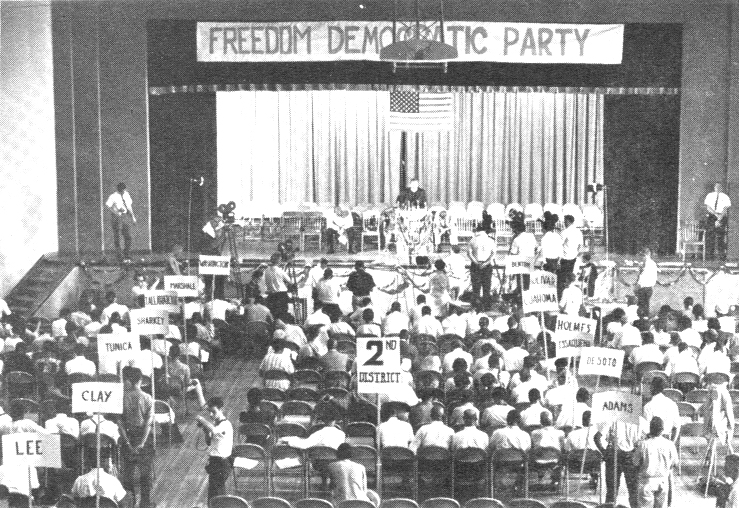August 1964
MFDP holds state convention
It was a stirring scene as nearly 2,500 Black Mississippians streamed into the Masonic Temple in Jackson, Mississippi for the MFDP’s state convention on August 6, 1964. As Stokely Carmichael peered about the hall, he beheld “all of these proud people sitting purposefully underneath their county signs.” The symbolism was not lost on Carmichael, who understood that for the convention’s participants, these signs “were a mark of accomplishment and pride” and were testaments to the “sacrifice, blood, and struggle” that had gone into building the MFDP.
During the summer, precinct meetings began paving the way for larger assemblies at the county and district levels, where Black delegates debated resolutions, gave speeches before their peers, and politicked to get their candidates to the Jackson convention.
Energy was high as delegates from around the state descended on the city for this final step in building the MFDP. There was an air of celebration. “There was not, could not have been, any state convention in the country that equaled ours in any way,” recalled Carmichael. “Not in spirit, not in fervor, and certainly not in singing.”

Fannie Lou Hamer (left) and Ella Baker (right) at MFDP statewide convention, August 6, 1964, crmvet.org
Ella Baker gave the convention’s keynote address, stressing the importance of education within the Black Freedom Struggle. “We have to deal with them on the basis of knowledge that we gain … through sending out children through certain kinds of courses, through sitting down and reading at night instead of spending our time at the television or radio just listening to what’s on.” “I think it was that summer,” remembered Carmichael, “night after night, meeting after meeting, that I really came to understand where Ms. Baker’s great faith in ordinary people came from.”
The participants gathered in the Masonic Temple elected a 68-person delegation, which largely consisted of homegrown activists noted for their determination and militancy. Most of them had been early supporters of SNCC and CORE in the state and formed the backbone of Mississippi’s increasingly determined civil rights movement. Among them: E.W. Steptoe from Amite County and Hartman Turnbow from Holmes County. The delegation also included Fannie Lou Hamer, Annie Devine, Unita Blackwell, and Victoria Gray–all of whom emerged as local leaders in COFO voter registration projects. The MFDP delegation uniquely raised the profile of rural Mississippians who brought with them a strong commitment to fight on behalf of all ignored and oppressed people in the state at the Democratic National Convention in Atlantic City.
Sources
Stokely Carmichael with Ekwueme Michael Thelwell, Ready for Revolution: The Life and Struggles of Stokely Carmichael (New York: Scribner, 2003).
John Dittmer, Local People: The Struggle for Civil Rights in Mississippi (Urbana: University of Illinois Press, 1994).
Mary King, Freedom Song: A Personal Story of the 1960s Civil Rights Movement (New York: William Morrow and Company, Inc., 1987).
Elizabeth Martinez, ed., Letters from Mississippi: Reports from Civil Rights Volunteers and Poetry of the 1964 Freedom Summer (Brookline, MA: Zephyr Press, 2007).
Robert P. Moses and Charles E. Cobb, Jr., Radical Equations: Civil Rights from Mississippi to the Algebra Project (Boston: Beacon Press, 2001).
Charles Payne, I’ve Got the Light of Freedom: The Organizing Tradition and the Mississippi Freedom Struggle (Berkeley: The University of California Press, 1995).





